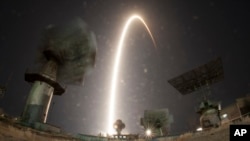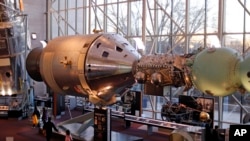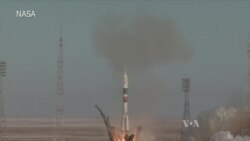Two American astronauts and a Russian cosmonaut are on their way to the International Space Station (ISS).
The three were launched from the Baikonur space port in Kazakhstan on Wednesday.
The launch comes at a time of increased tensions between Russia and the United States. Yet experts note that the two sides continue working together in space.
Amy Shira Teitel is a space flight historian. She notes that NASA, the U.S. space agency, depends on Russia to reach the space station.
“Currently, Russia’s our only way up to orbit for the International Space Station and for any other human mission."
Cathleen Lewis is with the Smithsonian Institution’s National Air and Space Museum in Washington. She works as a curator in the museum’s Space History Department.
Lewis says, since 2011, NASA has worked to develop its next generation of spacecraft. That means the space agency is depending on Russian cooperation.
“The Russians are partners in the International Space Station. Therefore, they were deemed reliable to be able to supply services to the space station. They have the Soyuz, which has been operational for 50 years now.”
Competitors cooperate even during Cold War
Cooperation in space between the two sides started in the 1970s during the Cold War. It was a period of intense competition between western countries and the Soviet Union.
But in 1975, an Apollo spacecraft linked up with a Soviet Soyuz spacecraft in Earth orbit. Cosmonauts and astronauts shook hands in space.
Lewis said that joint project was important.
“That created a bond, but also the knowledge that we could do this, even in the height of the Cold War, and probably one of the worse periods of the Cold War. That both sides could get together and do this, unperturbed by the politics going on around them.”
The “space race” between the United States and Russia ended in 1969 when NASA’s Apollo 11 brought two men to the moon.
However, space travel is dangerous and both the American and Soviet space programs suffered losses in their efforts to outdo each other in space.
The Apollo-Soyuz mission served to show that the two sides could work together in cooperation towards safety.
Currently, the U.S., Russia and 13 other countries cooperate to operate and supply the space station.
Future space missions will need even more cooperation because of the costs involved. Lewis said this model is likely to be important.
"It is going to take a lot of money, a lot of resources to ship there to make either the Moon or Mars habitable for humans. This will likely be the model in which humans explore our celestial neighbors in the solar system."
Currently, cooperation remains the only way to get American astronauts to the ISS.
American companies SpaceX and Boeing, however, are expected to have spacecraft able to safely carry humans in coming years.
I’m Mario Ritter.
Steve Baragona reported this story for VOANews.com. Mario Ritter adapted the report for Learning English. George Grow was the editor.
_____________________________________________________________
Words in This Story
mission – n. a project, program or operation
rely – v. to need for support, to depend on
curator – n. someone who cares for something, especially a person responsible for a show or exhibit
deem – v. to consider someone or something in a certain way
bond – n. something that connects
unperturbed – adj. not bothered, not worried
resource – n. a supply of something; a place or thing that provides something useful
habitable – adj. fit to be lived in, able to support life
celestial – adj. related to the sky, in the sky
We want to hear from you. Write to us in the Comments section, and visit our Facebook page.











